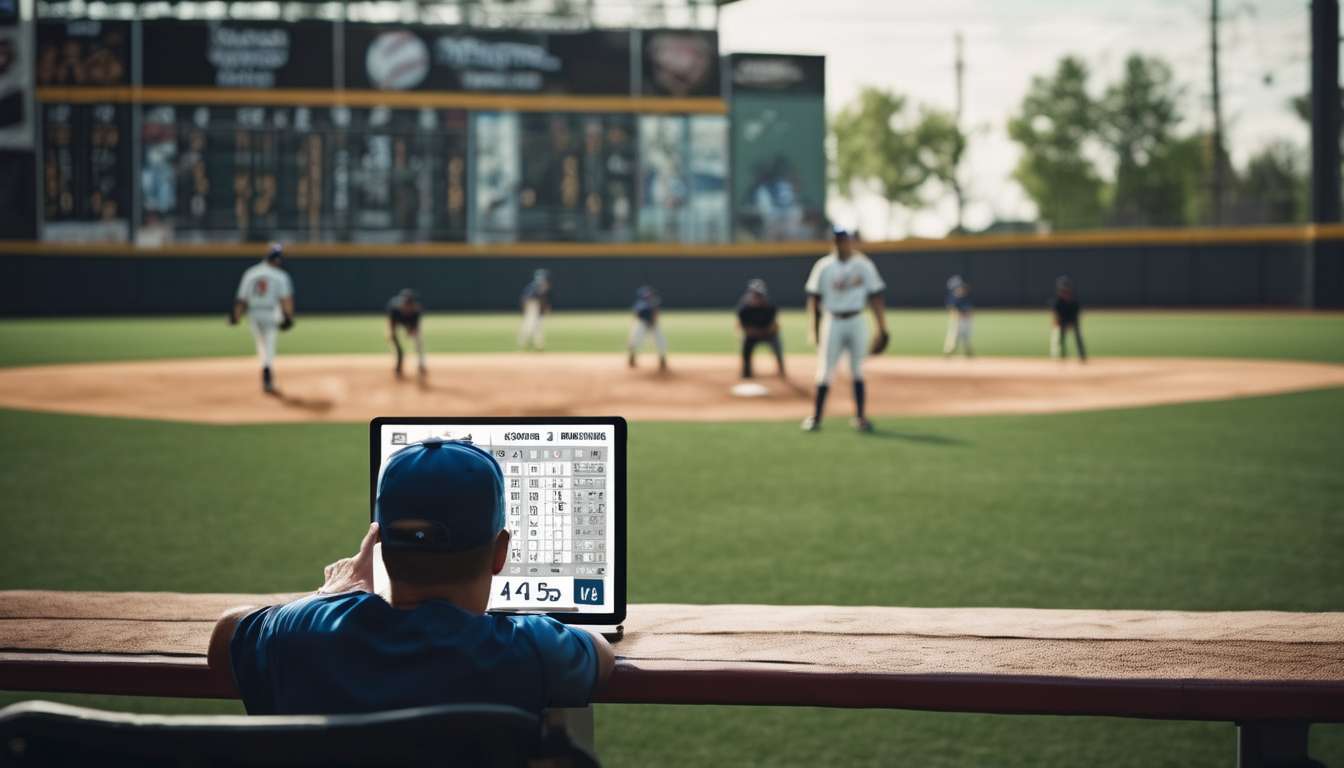In recent years, we have witnessed a fascinating evolution in the art of stealing bases, a skill that has always been a mix of strategy, speed, and sheer audacity. The current trends raise questions about how changes in pace, rules, and context have reshaped this thrilling aspect of baseball.
Impact of New Regulations:
- New regulations intended to quicken the game, such as the pitch clock and limits on pickoff attempts, have significantly influenced base runners’ decision-making.
- These changes have pressured pitchers to be more predictable, giving base stealers an edge.
Advancements in Player Analytics and Training:
- The broader context of advancements in player analytics allows teams to better identify optimal situations for stealing bases.
- Modern training techniques have redefined what it means to be an effective base stealer, focusing on improving speed, agility, and reaction times.
Resurgence in Stolen Bases:
- By examining these elements, we uncover the nuances that have led to a resurgence in stolen bases.
- Insights reveal how teams and players are adapting to this dynamic facet of the sport, incorporating both traditional skills and modern technology.
Together, these factors illustrate how the art of stealing bases continues to evolve, maintaining its place as a thrilling and strategic component of baseball.
Pitch Clock and Pickoff Limits
The introduction of the pitch clock and limits on pickoff attempts has significantly impacted the pace and strategy of stolen bases in baseball. We’ve seen our beloved game adapt to these changes, and it’s fascinating to witness how teams are embracing analytics to refine their approach.
The pitch clock creates a dynamic environment where pitchers, catchers, and runners must be in sync. As fans, we watch managers and players adapt to the new pace, making strategic decisions that weren’t necessary before.
With pitchers having less time to deliver the ball, the opportunity for stolen bases increases. We’re thrilled by the excitement of a well-timed steal. Analytics play a crucial role in this adaptation, helping teams identify the best moments to exploit these changes.
In this era of baseball, we’re united by our shared love for the game and our curiosity about how these new rules will shape the future of stolen bases.
Impact on Base Runners’ Decisions
Base runners now face a myriad of split-second decisions as they gauge the ideal moments to take advantage of the new rules. With the pitch clock ticking away, we’re forced to adapt quickly, finding that perfect rhythm to steal bases.
Analytics have become our steadfast allies, helping us identify patterns in pitchers’ habits and tendencies. The sense of community among us sharpens as we exchange insights, each of us striving to outsmart the pitcher and gain that crucial advantage.
The new rules mean we’ve got to be more strategic than ever. The pitch clock limits the time a pitcher can hold us on base, increasing our opportunities. We embrace the challenge by:
- Honing our instincts
- Refining our timing
- Trusting our gut
- Relying on our teammates
- Using every bit of data at our disposal
Together, we thrive on this shared experience, knowing that our collective adaptation keeps us a step ahead in the game.
Player Analytics in Base Stealing
Our reliance on player analytics has revolutionized our approach to base stealing, providing us with precise data to optimize every attempt. We’re not just guessing anymore; we’re using detailed insights to make informed decisions that align us with the game’s evolving dynamics. As a community passionate about baseball, we understand that analytics is our beacon, guiding us in this new era.
The introduction of the pitch clock has pushed us to adapt swiftly. Every second counts, and analytics help us anticipate the perfect moment to steal. By studying:
- Pitcher tendencies
- Runner speed
- Timing
we’ve elevated our strategies to an art form. It’s not just about speed; it’s about timing and insight.
We’re united in our pursuit of excellence, leveraging analytics to enhance our game. Together, we embrace the changes, share the wins, and learn from the misses. Our shared commitment to adaptation ensures we’re always ready to outsmart our opponents on the diamond.
Training Techniques Redefining Speed
Our training techniques are constantly evolving to sharpen our speed on the base paths. Together, we’ve embraced a culture of innovation, where the pitch clock challenges us to adapt quickly, pushing our limits.
This shared journey isn’t just about individual performance; it’s about building a community that thrives on collective growth. We use analytics to dissect every movement, identifying opportunities to gain those precious milliseconds that separate success from failure.
Key Focus Areas:
- Drills that enhance reaction times
- Ensuring sync with the game’s new fast-paced rhythm
By incorporating real-time data and feedback, we tailor our training to each player’s unique strengths and weaknesses. This fosters an environment of continuous improvement.
Adaptation is our mantra. As we learn and grow together, we solidify our place in the evolving landscape of baseball. In this space, we all belong, united by our shared commitment to redefine speed and outpace the competition.
Resurgence Factors in Stolen Bases
Several key factors have contributed to the resurgence of stolen bases in recent seasons.
Introduction of the Pitch Clock:
- The pitch clock has added pressure on pitchers to deliver the ball faster.
- This change gives base runners the edge they need to take off.
- It has reinvigorated the strategic dance between pitcher, catcher, and runner, bringing excitement back to the base paths.
Role of Analytics:
- Analytics have revolutionized our understanding of when and how to steal bases.
- Teams are making informed decisions based on data highlighting pitchers’ tendencies and catchers’ weaknesses.
- This approach has increased success rates and encouraged more attempts, making stolen bases a pivotal part of game strategy.
Adaptation and Community Embrace:
- Teams and players are embracing these changes, seeking every advantage.
- We are witnessing a thrilling era where stolen bases are once again a celebrated art form.
Together, these elements contribute to a dynamic and exciting evolution in the game.
Nuances of Adaptation to Trends
We’ve seen teams quickly adapt to the evolving trends in stolen bases, showcasing their agility in strategy and execution. As we journey through this dynamic landscape, it’s clear that the pitch clock has significantly influenced our approach. By incorporating this new timing element, we’ve gained a fresh perspective on when to make our move. This shift underscores the importance of being present and attuned to the rhythm of the game, creating a shared experience for fans and players alike.
Analytics have become our compass, guiding us through the intricate maze of adaptation. We’ve embraced data-driven insights to fine-tune our tactics, allowing us to anticipate opponents’ strategies and capitalize on opportunities. This collective effort fosters a sense of unity among us, as we work together to navigate the challenges and celebrate the victories.
By understanding these nuances, we continue to strengthen our connection to the game, ensuring that we’re always ready to evolve alongside it.
Evolution of Base Stealing Strategies
Over the years, we’ve witnessed a remarkable transformation in base stealing strategies, driven by a blend of innovation and tradition.
The introduction of the pitch clock has injected a new rhythm into the game, demanding that we adapt our timing and techniques. It’s not just about speed anymore but understanding the pitcher’s cadence and exploiting any slight delay. We’ve honed our skills, turning base stealing into a dance of precision and anticipation.
In our community, analytics have become a cornerstone of strategy. We analyze every pitch and every movement, finding patterns that give us an edge. It’s a collective effort where data meets instinct, and everyone plays a part in shaping our success.
Our strategies have evolved; we’re more informed and more connected.
Adaptation is the heartbeat of our evolution. We’ve embraced change yet held onto the core values that make base stealing thrilling. Together, we navigate this ever-evolving landscape, using every tool and insight to outsmart the competition.
Balancing Tradition and Technology
In our quest to balance tradition and technology, we constantly evaluate how emerging tools can enhance our time-honored base stealing tactics. It’s essential to preserve the spirit of the game while embracing innovations that can elevate our strategy.
The pitch clock challenges us to time our sprints with precision, adding a new layer of excitement and urgency to the base paths.
Analytics play a critical role in our adaptation, offering insights that were once unimaginable. By analyzing:
- Pitcher tendencies
- Defensive alignments
we gain an edge that aligns seamlessly with our traditional instincts. Using data effectively, we can anticipate the perfect moment to make our move, increasing our success rate and fostering a deeper sense of unity among the team.
Together, we navigate this evolving landscape, ensuring that while technology drives us forward, the essence of base stealing remains intact. As a collective, we honor the past and embrace the future, becoming pioneers in this new era.
What historical events have significantly influenced the evolution of stolen base strategies in baseball?
As we look back on the history of baseball, numerous events have shaped the way stolen base strategies have evolved over time.
From the speed demons of the early days to the introduction of analytics in modern baseball, each era has brought its own unique influences.
These changes have forced teams to adapt and innovate, leading to a dynamic and ever-changing approach to stealing bases on the diamond.
Key Influences on Stolen Base Strategies:
-
Early Days:
- Speed was the primary factor.
- Players relied heavily on raw athleticism.
-
Mid-20th Century:
- Introduction of more structured training.
- Emphasis on technique and timing.
-
Modern Era:
- Use of analytics to determine optimal situations for stealing.
- Consideration of player statistics and pitcher tendencies.
Adaptation and Innovation:
- Teams have continuously adjusted their strategies to stay competitive.
- Modern training focuses on both physical and data-driven insights.
Each of these influences has contributed to the rich and evolving history of base stealing in baseball.
How do weather conditions affect the frequency and success rate of stolen bases?
Weather conditions play a crucial role in determining the frequency and success rate of stolen bases.
Rainy or windy weather can affect the speed of the ball, making it harder for catchers to throw accurately. In these conditions, we tend to see an increase in successful stolen bases as runners take advantage of the slower play.
Understanding how weather impacts stolen bases helps us adapt our strategies for optimal performance on the field.
What psychological factors do players consider when deciding to attempt a stolen base?
When deciding to attempt a stolen base, players consider various psychological factors:
- Confidence in their speed, agility, and timing.
- Assessment of the pitcher’s tendencies and pickoff moves.
Additionally, players may factor in the game situation, which includes:
- The score of the game.
- The inning in which the game is currently.
- The presence and positions of base runners ahead or behind them.
These elements collectively influence a player’s decision to attempt a stolen base.
Conclusion
You’ve explored the dynamic landscape of stolen base trends in baseball, from the influence of pitch clocks and pickoff limits to the evolving strategies guided by player analytics and training techniques.
Influences on Stolen Base Trends:
-
Pitch Clocks and Pickoff Limits: These elements have significantly impacted the frequency and success rate of stolen bases, creating new opportunities and challenges for base runners.
-
Player Analytics and Training Techniques: Advanced analytics have enabled teams to optimize base-stealing strategies, while modern training methods have enhanced players’ speed and agility.
As the game continues to balance tradition with technology, the nuances of adaptation and resurgence factors in stolen bases will shape the future of base stealing.
Future of Base Stealing:
-
Adaptation: Teams will need to continuously adapt to new rules and technologies that affect base-stealing dynamics.
-
Resurgence Factors: Understanding and leveraging factors that contribute to a resurgence in stolen bases will be crucial for teams aiming to gain a competitive edge.
Stay tuned as the evolution in base stealing strategies continues to redefine the pace and context of America’s favorite pastime.




